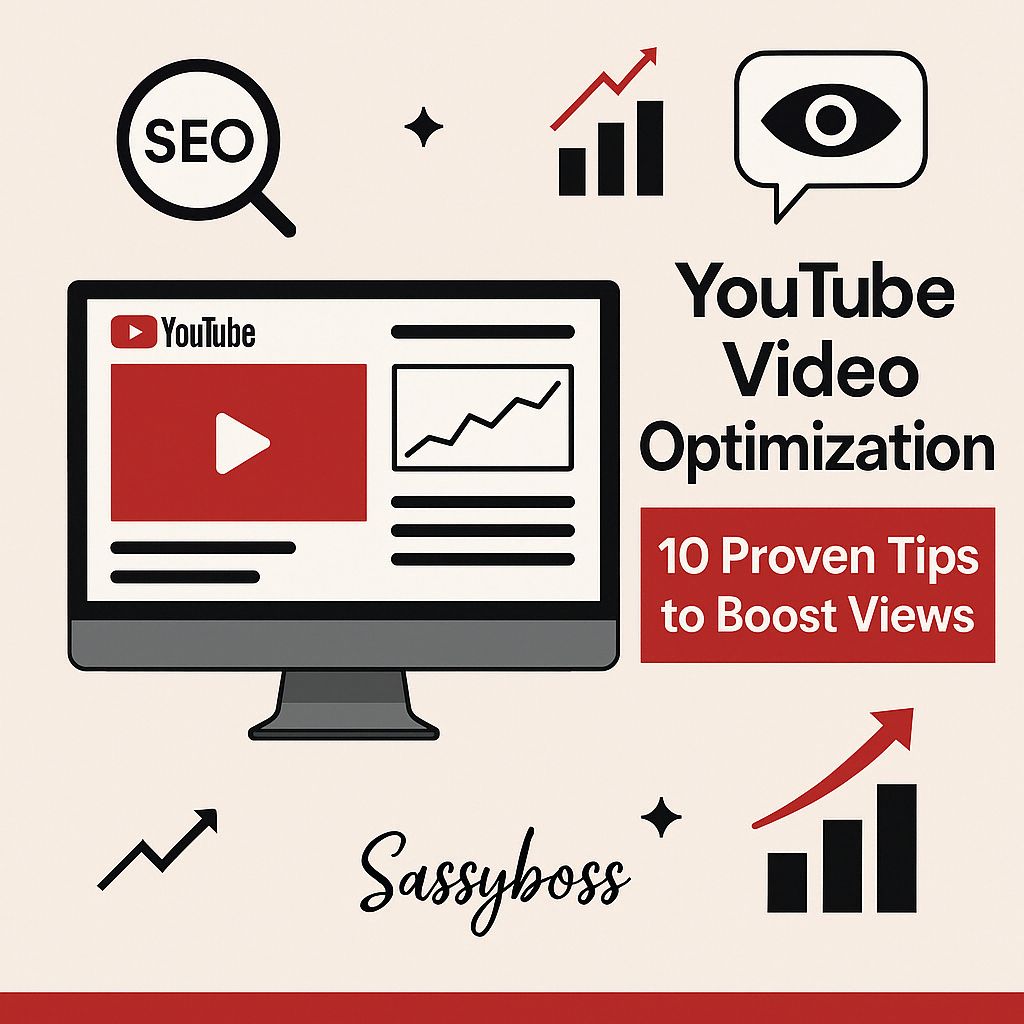YouTube Video Optimization: 10 Proven Tips to Boost Views
In today’s digital age, YouTube is more than just a platform for entertainment—it’s a powerful search engine, a marketing goldmine, and a career-launching stage for creators worldwide. But with over 500 hours of video uploaded every minute, standing out on YouTube can feel impossible. That’s where YouTube video optimization comes in.
Whether you’re a beginner or a seasoned YouTuber, optimizing your videos can dramatically increase your visibility, drive more traffic, and ultimately, grow your audience. In this post, we’ll walk you through 10 proven YouTube video optimization tips that will help your content reach its full potential.
1. Do Keyword Research First
Just like with Google SEO, YouTube optimization starts with targeting the right keywords. These are the words and phrases people type into YouTube’s search bar.
How to do it:
• Use tools like TubeBuddy, VidIQ, or Ahrefs YouTube Keyword Tool to find keywords with high search volume and low competition.
• Check the autocomplete suggestions on YouTube by typing your main topic into the search bar.
• Look at your competitors’ top-performing videos to see what keywords they’re targeting.
Pro Tip:
Include your focus keyword in your video title, description, and tags. For example, in this post, our focus keyword is “YouTube video optimization.”
2. Craft a Compelling Video Title
Your video title is the first thing viewers see, and it’s also one of the most important ranking factors on YouTube.
Tips for writing great titles:
• Keep it under 60 characters so it doesn’t get cut off.
• Include your target keyword near the beginning.
• Make it attention-grabbing by including numbers, questions, or power words.
Example:
Instead of saying “How to Get More Views,” go with “10 YouTube Video Optimization Tips to Skyrocket Views.”
3. Write an Optimized Description
Your video description is valuable real estate. Not only does it give context to your video, but it’s also a major factor in how your content ranks in YouTube search.
What to include:
• A strong opening sentence with your keyword.
• A detailed explanation of your video’s content (at least 250 words).
• Timestamps for key sections.
• Links to your website, social media, or related content.
Example opening:
“This video dives into YouTube video optimization and shares 10 proven strategies to help you get more views and grow your channel.”
4. Use Eye-Catching Thumbnails
Your thumbnail is like the cover of a book—if it’s not appealing, viewers might scroll right past your content.
Best practices:
• Use high contrast colors and bold fonts.
• Include a close-up face with emotion when possible.
• Add short text overlays to highlight the video topic.
• Keep your branding consistent across all thumbnails.
Thumbnails don’t directly influence YouTube’s algorithm, but they significantly impact your click-through rate (CTR)—which does affect rankings.
5. Add Tags Strategically
Tags are not as powerful as they once were, but they still help YouTube understand your video’s context—especially if your title or description is unclear.
Tagging tips:
• Include your main keyword as the first tag.
• Add related keywords and long-tail variations.
• Use both broad and specific tags (e.g., “video SEO” and “how to optimize YouTube videos”).
6. Create Custom Video Chapters
Video chapters (also known as timestamps) not only make your content easier to navigate, but they also increase audience retention and improve SEO.
How to add them:
In your video description, list timestamps like this:
00:00 Introduction 01:15 Keyword Research 03:30 Optimized Titles ...
YouTube automatically turns them into clickable chapters, enhancing the user experience and signaling content relevance to the algorithm.
7. Encourage Engagement
Engagement metrics like likes, comments, and shares tell YouTube that people are enjoying your content, which boosts your chances of getting recommended.
How to increase engagement:
• Ask questions during the video to prompt comments.
• Include CTAs (calls-to-action) like “Give this video a thumbs up” or “Comment your favorite tip below.”
• Respond to comments to build community and encourage more interaction.
8. Optimize for Watch Time and Retention
YouTube favors videos that keep people watching. Higher average view duration and audience retention lead to better rankings and more recommendations.
Tips to increase watch time:
• Hook viewers in the first 15 seconds.
• Use pattern interrupts like zooms, graphics, and cuts to keep things dynamic.
• Plan your content structure to build interest and deliver value throughout.
9. Use End Screens and Cards
These interactive elements help you guide viewers to more of your content, which boosts your channel session time—another ranking signal.
What to do:
• Use end screens in the final 20 seconds to promote related videos or playlists.
• Add cards during key moments to suggest additional content.
• Link to a playlist instead of a single video when possible to encourage binge-watching.
10. Promote Your Video Outside of YouTube
Optimization doesn’t stop on the platform. External traffic signals also help YouTube determine video quality.
Promotion ideas:
• Share your video on social media (Twitter, Facebook, LinkedIn, Reddit).
• Embed it in your blog posts or website.
• Include the video in your email newsletters.
• Collaborate with other creators to cross-promote.
Final Thoughts
YouTube video optimization is a game-changer for creators who want to grow their audience and boost video visibility. By applying these 10 proven tips, you’re not only improving your chances of being discovered but also delivering a better experience for your viewers.
Remember, YouTube success doesn’t happen overnight. But with consistent effort and smart optimization, you’ll be well on your way to a thriving channel.
What’s your go-to YouTube optimization tactic? Share it in the comments below!
